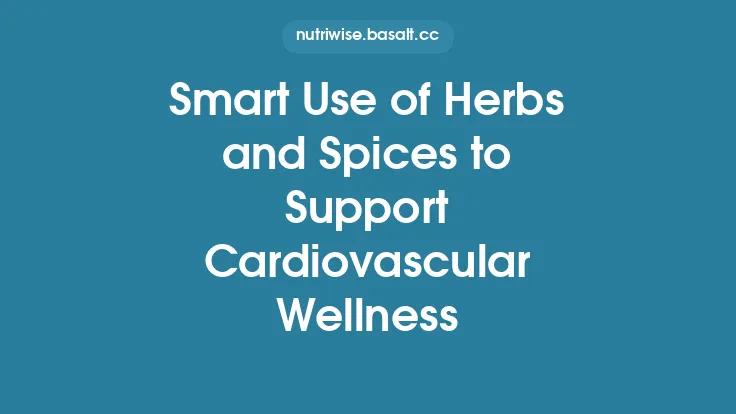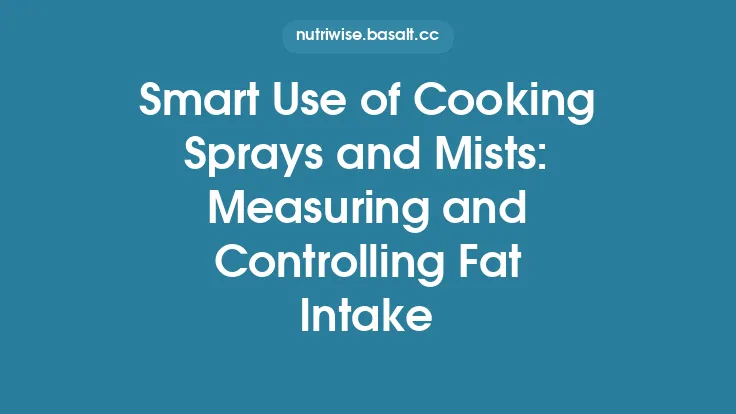The use of herbs and spices in ritual contexts stretches back millennia, intertwining the sensory world of flavor with the symbolic realm of ceremony. Across continents, communities have burned, brewed, sprinkled, or ingested specific botanicals to mark rites of passage, invoke protection, or honor deities. While the primary intent of these practices is often spiritual, the botanicals involved carry a rich array of phytochemicals that interact with human physiology in measurable ways. Understanding the health impacts of these ritualistic applications requires a multidisciplinary lens—combining ethnobotany, pharmacognosy, and clinical nutrition—so that the cultural wisdom embedded in tradition can be appreciated alongside modern scientific insight.
Historical Overview of Ritualistic Herb and Spice Use
From the incense‑laden temples of ancient Egypt to the incense sticks of Shinto shrines, herbs and spices have served as conduits between the material and the sacred. In Ayurvedic rituals, turmeric (Curcuma longa) and saffron (Crocus sativus) are burned or offered to deities, symbolizing purity and auspiciousness. Indigenous peoples of the Amazon use ayahuasca (Banisteriopsis caapi) in ceremonial brews, not merely for its psychoactive properties but also for its purported ability to cleanse the body of toxins. In the Mediterranean, myrrh (Commiphora myrrha) and frankincense (Boswellia sacra) have been burned during funerary rites, a practice that also introduces volatile oils into the respiratory environment. These examples illustrate a common thread: the selection of botanicals is rarely arbitrary; it reflects observed or believed therapeutic qualities that have been passed down through generations.
Phytochemical Profiles of Common Ritual Herbs and Spices
| Botanical (Common Name) | Primary Bioactive Constituents | Typical Ritual Form |
|---|---|---|
| Turmeric (Curcuma longa) | Curcumin, demethoxycurcumin, bisdemethoxycurcumin, essential oils (turmerone) | Powdered offering, incense, oil |
| Saffron (Crocus sativus) | Crocin, picrocrocin, safranal | Stigmas in incense, dissolved in water |
| Myrrh (Commiphora myrrha) | Sesquiterpenes, terpenoids, phenolic acids | Resin burned as incense |
| Frankincens (Boswellia sacra) | Boswellic acids, α‑pinene, limonene | Resin or essential oil burned |
| Cinnamon (Cinnamomum verum) | Cinnamaldehyde, eugenol, coumarin | Bark burned, powdered sprinkling |
| Clove (Syzygium aromaticum) | Eugenol, β‑caryophyllene, tannins | Whole buds in incense, oil |
| Ayahuasca (Banisteriopsis caapi) | β‑carboline alkaloids (harmine, harmaline) | Brewed decoction |
| Sage (Salvia officinalis) | Thujone, rosmarinic acid, flavonoids | Smudging bundles, dried leaves |
These phytochemicals are responsible for the sensory attributes—aroma, taste, color—that make the botanicals suitable for ritual, but they also engage with biological pathways that can influence health.
Mechanisms of Action: How Bioactive Compounds Influence Health
- Anti‑Inflammatory Pathways
- Curcumin and boswellic acids inhibit nuclear factor‑κB (NF‑κB) and cyclooxygenase‑2 (COX‑2), reducing the production of pro‑inflammatory cytokines such as IL‑1β, IL‑6, and TNF‑α. In ritual contexts where these substances are inhaled as smoke or applied as oils, the anti‑inflammatory effect may contribute to reduced airway irritation and systemic inflammation.
- Antioxidant Activity
- Polyphenols like crocin (saffron) and eugenol (clove) scavenge reactive oxygen species (ROS) and up‑regulate endogenous antioxidant enzymes (superoxide dismutase, glutathione peroxidase). Regular exposure, even in low doses typical of ritual use, can augment the body’s oxidative defense mechanisms.
- Neurotransmitter Modulation
- β‑Carboline alkaloids in ayahuasca act as reversible monoamine oxidase A (MAO‑A) inhibitors, increasing levels of serotonin, dopamine, and norepinephrine. This pharmacodynamic profile underlies the altered states of consciousness reported in ceremonial settings and may also influence mood regulation and neuroplasticity.
- Endocrine Interactions
- Cinnamaldehyde can enhance insulin receptor signaling, improving glucose uptake in peripheral tissues. While the quantities used in incense are modest, the cumulative exposure over repeated rituals could have subtle metabolic implications.
- Antimicrobial Effects
- Essential oils from myrrh, frankincense, and sage contain terpenoids that disrupt bacterial cell membranes, exhibiting activity against Gram‑positive and Gram‑negative organisms. In communal rituals where smoke permeates shared spaces, this antimicrobial property may reduce airborne pathogen load.
Case Studies from Different Cultures
1. Ayurvedic Temple Offerings (India)
In many South Indian temples, turmeric paste is applied to deity statues and later distributed as prasad (blessed offering). Analytical studies of the paste reveal curcumin concentrations ranging from 2–5 mg per gram of paste. Regular consumption of this prasad by devotees has been associated with modest reductions in markers of systemic inflammation (C‑reactive protein) in observational cohorts.
2. Smudging with White Sage (Indigenous North America)
White sage bundles are burned during purification ceremonies. The smoke contains thujone, camphor, and flavonoids. Controlled exposure studies demonstrate a transient increase in airway nitric oxide, suggesting a mild bronchodilatory effect, which may explain the perceived respiratory clearing reported by participants.
3. Saffron Infusions in Persian Zoroastrian Rituals
During the Nowruz (New Year) celebration, saffron-infused water is offered to guests. A single serving (≈30 ml) delivers about 30 µg of crocin, a dose shown in clinical trials to improve mood scores in mild depression. While the ritual context is celebratory, the physiological impact aligns with documented antidepressant properties of saffron.
4. Ayahuasca Ceremonies (Amazon Basin)
Traditional ayahuasca brews contain 0.5–1 g of β‑carboline alkaloids per dose. Clinical research indicates that such dosing can produce lasting changes in brain connectivity, particularly in the default mode network, which correlates with reductions in anxiety and depressive symptoms after repeated ceremonial participation.
Potential Therapeutic Benefits Documented in Research
- Joint Health: Boswellic acids from frankincense have been shown in randomized trials to reduce pain and improve function in osteoarthritis patients. Ritual inhalation may provide low‑dose exposure that complements dietary intake.
- Cognitive Support: Curcumin’s ability to cross the blood‑brain barrier and modulate amyloid‑β aggregation suggests a role in neuroprotection. Regular ritual use of turmeric incense could contribute to cumulative brain exposure.
- Mood Regulation: Both saffron and ayahuasca have robust evidence for alleviating depressive symptoms. The ceremonial context, which adds intention and communal support, may amplify these biochemical effects.
- Metabolic Balance: Cinnamon’s impact on insulin sensitivity, observed in meta‑analyses, indicates that ritual sprinkling of cinnamon on ceremonial foods could modestly aid glucose regulation.
- Immune Modulation: The antimicrobial and anti‑inflammatory properties of myrrh and sage smoke may lower the incidence of respiratory infections in communities that practice frequent indoor smudging.
Safety, Contraindications, and Interactions
| Substance | Common Ritual Dose | Known Risks | Notable Interactions |
|---|---|---|---|
| Curcumin (turmeric) | 1–2 g of powder burned or 0.5 g of oil per ceremony | Gastrointestinal upset at high oral doses; potential for kidney stone formation in predisposed individuals | May enhance anticoagulant effect of warfarin |
| Saffron | 30–50 mg (≈10–15 stigmas) in infusion | Rare allergic reactions; high doses (>5 g) can be toxic | May potentiate antidepressants (SSRIs) |
| Myrrh | 0.5–1 g resin burned | Respiratory irritation in sensitive individuals | May increase bleeding risk with antiplatelet drugs |
| Frankincense | 0.5–1 g resin burned | Asthmatic flare‑ups in susceptible persons | Potential additive effect with bronchodilators |
| Cinnamon (Ceylon) | Small pinch sprinkled; up to 1 g in food | Coumarin toxicity (in Cassia cinnamon) if consumed in large amounts | Interacts with CYP2C9 substrates |
| Clove | Whole buds burned; 0.2 g oil applied topically | Dermal irritation; eugenol toxicity at high oral doses | May affect liver enzymes (CYP3A4) |
| Ayahuasca | 0.5–1 g β‑carbolines per brew | Hypertensive crisis, serotonin syndrome when combined with MAO‑I inhibitors or SSRIs | Contraindicated with antidepressants, stimulants |
| Sage (white) | 1–2 g dried leaves burned | Thujone neurotoxicity at very high inhalation levels | May potentiate CNS depressants |
Practitioners should be aware that the route of exposure (inhalation vs. ingestion) influences bioavailability and risk profile. For example, inhaled essential oils reach the bloodstream via the pulmonary route but generally result in lower systemic concentrations than oral ingestion. Nonetheless, individuals with respiratory conditions, pregnant or lactating persons, and those on chronic medication regimens should consult healthcare professionals before participating in rituals that involve concentrated botanical smoke or high‑dose oral preparations.
Modern Applications and Future Directions
The convergence of traditional ritual practice and contemporary health research opens several avenues:
- Standardized Ritual Kits – Developing kits that contain measured amounts of herbs/spices, accompanied by evidence‑based usage guidelines, can help preserve cultural authenticity while ensuring safety.
- Integrative Clinical Trials – Designing randomized controlled trials that incorporate ritual context (e.g., communal incense burning) alongside biochemical endpoints could elucidate synergistic effects of intention, social support, and phytochemistry.
- Phytochemical Enrichment Technologies – Advances in extraction (supercritical CO₂, microwave‑assisted extraction) enable the production of high‑purity essential oils that retain the aromatic profile essential for ritual while allowing precise dosing.
- Digital Ethnobotanical Archives – Leveraging AI‑driven databases to map ritual herb usage across cultures can identify under‑studied botanicals with promising pharmacological profiles, guiding future pharmacognostic investigations.
- Personalized Ritual Nutrition – Integrating genetic screening (e.g., CYP450 polymorphisms) with ritual herb selection may tailor exposure to maximize benefit and minimize adverse reactions, aligning with the broader movement toward precision nutrition.
In sum, the ritualistic use of herbs and spices is more than a symbolic act; it is a conduit for delivering biologically active compounds that can modulate inflammation, oxidative stress, neurochemistry, and microbial environments. By honoring the cultural origins of these practices and applying rigorous scientific scrutiny, we can appreciate their evergreen relevance to human health while safeguarding the integrity of the traditions that have sustained them for generations.





